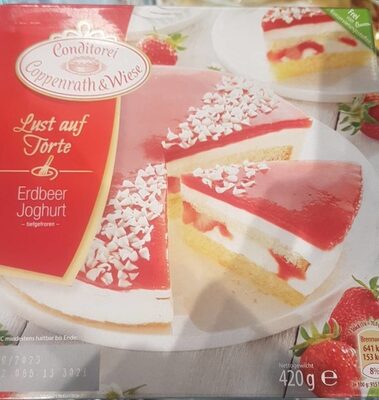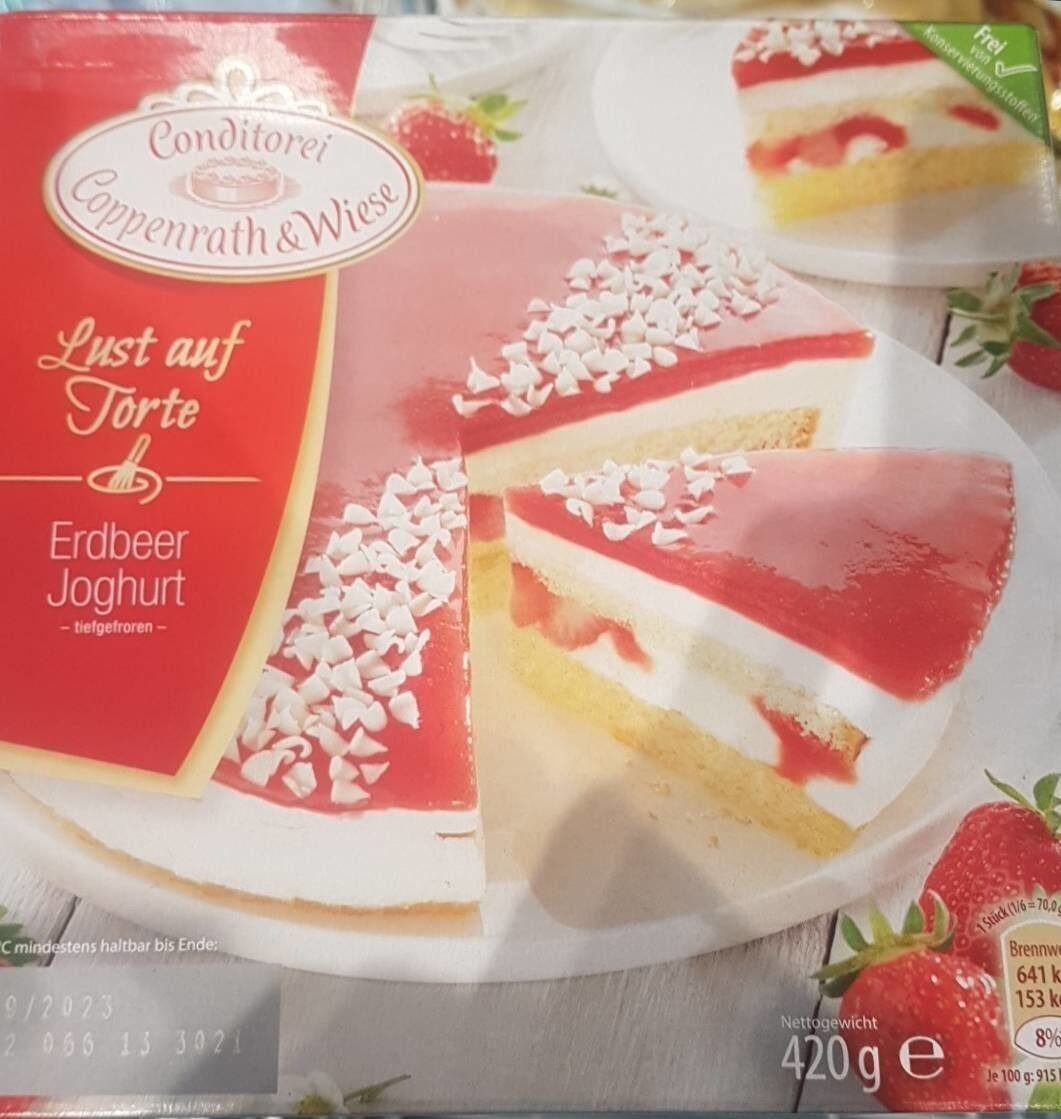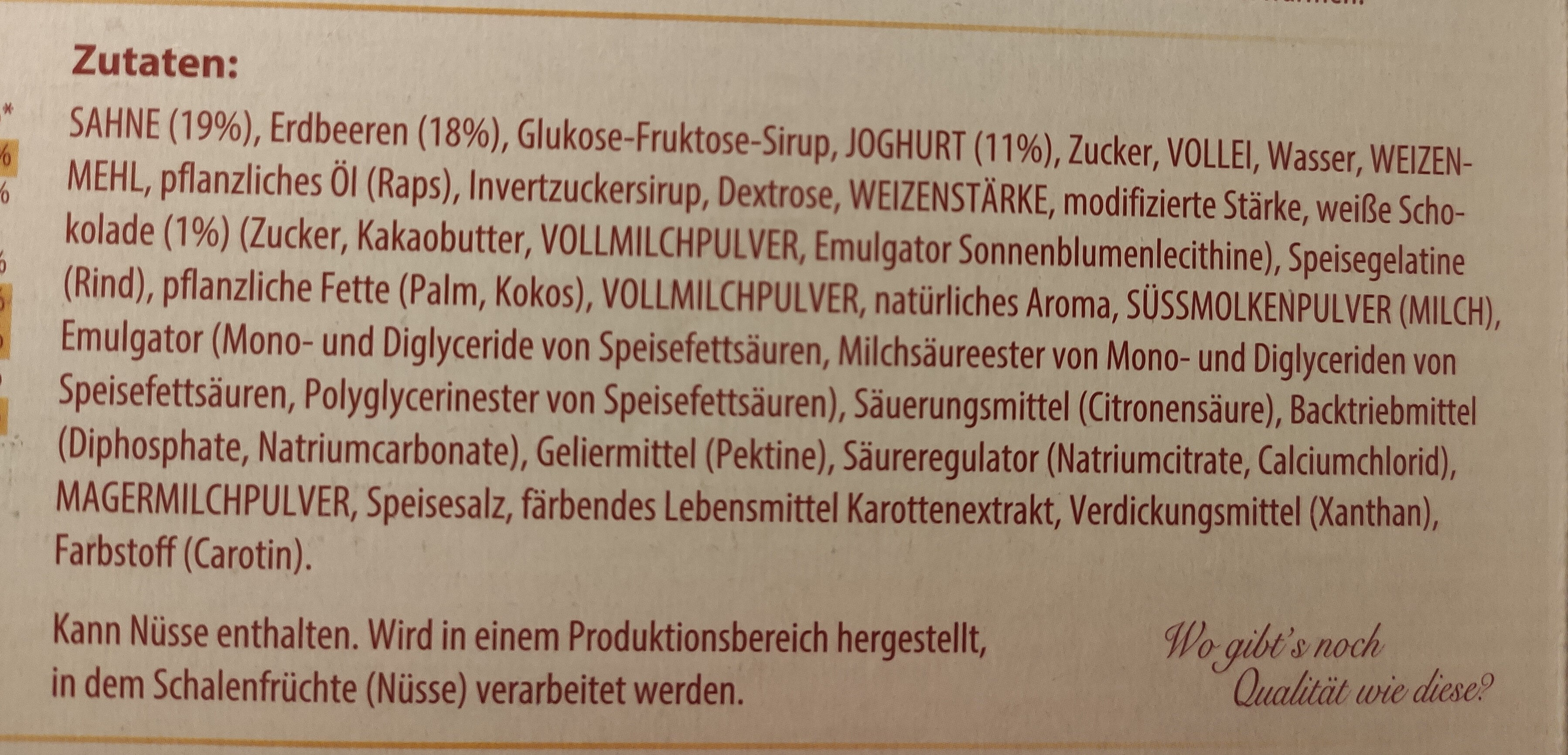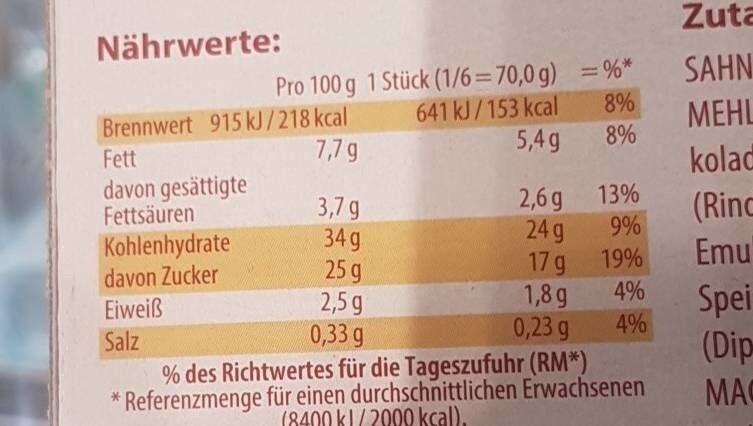Help us make food transparency the norm!
As a non-profit organization, we depend on your donations to continue informing consumers around the world about what they eat.
The food revolution starts with you!
Erdbeer Joghurt Torte - Coppenrath & Wiese - 420 g
Erdbeer Joghurt Torte - Coppenrath & Wiese - 420 g
This product page is not complete. You can help to complete it by editing it and adding more data from the photos we have, or by taking more photos using the app for Android or iPhone/iPad. Thank you!
×
Barcode: 4008577020625 (EAN / EAN-13)
Quantity: 420 g
Brands: Coppenrath & Wiese
Categories: Snacks, Sweet snacks, Biscuits and cakes, Cakes
Labels, certifications, awards: No preservatives
Countries where sold: Germany
Matching with your preferences
Health
Ingredients
-
48 ingredients
: SAHNE (19%), Erdbeeren (18%), Glukose-Fruktose-Sirup, JOGHURT (11%), Zucker, VOLLEI, Wasser, WEIZEN - MEHL, pflanzliches Öl (Raps), Invertzuckersirup, Dextrose, WEIZENSTÄRKE, modifizierte Stärke, weiße Schokolade (1%) (Zucker, Kakaobutter, VOLLMILCHPULVER, Sonnenblumenlecithine), Speisegelatine (Rind), pflanzliche Fette (Palm, Kokos), VOLLMILCHPULVER, natürliches Aroma, SÜSSMOLKENPULVER (MILCH), Emulgator (Mono - und Diglyceride von Speisefettsäuren, Milchsäureester von Mono - und Diglyceriden von Speisefettsäuren, Polyglycerinester von Speisefettsäuren), Säuerungsmittel (Citronensäure), Backtriebmittel (Diphosphate, Natriumcarbonate), Geliermittel (Pektine), Säureregulator (Natriumcitrate, Calciumchlorid), MAGERMILCHPULVER, Speisesalz, Karottenextrakt, Verdickungsmittel (Xanthan), Farbstoff (Carotin).Allergens: Eggs, Gluten, MilkTraces: Nuts
Food processing
-
Ultra processed foods
Elements that indicate the product is in the 4 - Ultra processed food and drink products group:
- Additive: E14XX - Modified Starch
- Additive: E160a - Carotene
- Additive: E415 - Xanthan gum
- Additive: E428 - Gelatine
- Additive: E440 - Pectins
- Additive: E450 - Diphosphates
- Additive: E471 - Mono- and diglycerides of fatty acids
- Additive: E472b - Lactic acid esters of mono- and diglycerides of fatty acids
- Additive: E475 - Polyglycerol esters of fatty acids
- Ingredient: Colour
- Ingredient: Dextrose
- Ingredient: Emulsifier
- Ingredient: Flavouring
- Ingredient: Gelling agent
- Ingredient: Glucose
- Ingredient: Invert sugar
- Ingredient: Thickener
- Ingredient: Whey
Food products are classified into 4 groups according to their degree of processing:
- Unprocessed or minimally processed foods
- Processed culinary ingredients
- Processed foods
- Ultra processed foods
The determination of the group is based on the category of the product and on the ingredients it contains.
Additives
-
E160a - Carotene
Carotene: The term carotene -also carotin, from the Latin carota, "carrot"- is used for many related unsaturated hydrocarbon substances having the formula C40Hx, which are synthesized by plants but in general cannot be made by animals -with the exception of some aphids and spider mites which acquired the synthesizing genes from fungi-. Carotenes are photosynthetic pigments important for photosynthesis. Carotenes contain no oxygen atoms. They absorb ultraviolet, violet, and blue light and scatter orange or red light, and -in low concentrations- yellow light. Carotenes are responsible for the orange colour of the carrot, for which this class of chemicals is named, and for the colours of many other fruits, vegetables and fungi -for example, sweet potatoes, chanterelle and orange cantaloupe melon-. Carotenes are also responsible for the orange -but not all of the yellow- colours in dry foliage. They also -in lower concentrations- impart the yellow coloration to milk-fat and butter. Omnivorous animal species which are relatively poor converters of coloured dietary carotenoids to colourless retinoids have yellowed-coloured body fat, as a result of the carotenoid retention from the vegetable portion of their diet. The typical yellow-coloured fat of humans and chickens is a result of fat storage of carotenes from their diets. Carotenes contribute to photosynthesis by transmitting the light energy they absorb to chlorophyll. They also protect plant tissues by helping to absorb the energy from singlet oxygen, an excited form of the oxygen molecule O2 which is formed during photosynthesis. β-Carotene is composed of two retinyl groups, and is broken down in the mucosa of the human small intestine by β-carotene 15‚15'-monooxygenase to retinal, a form of vitamin A. β-Carotene can be stored in the liver and body fat and converted to retinal as needed, thus making it a form of vitamin A for humans and some other mammals. The carotenes α-carotene and γ-carotene, due to their single retinyl group -β-ionone ring-, also have some vitamin A activity -though less than β-carotene-, as does the xanthophyll carotenoid β-cryptoxanthin. All other carotenoids, including lycopene, have no beta-ring and thus no vitamin A activity -although they may have antioxidant activity and thus biological activity in other ways-. Animal species differ greatly in their ability to convert retinyl -beta-ionone- containing carotenoids to retinals. Carnivores in general are poor converters of dietary ionone-containing carotenoids. Pure carnivores such as ferrets lack β-carotene 15‚15'-monooxygenase and cannot convert any carotenoids to retinals at all -resulting in carotenes not being a form of vitamin A for this species-; while cats can convert a trace of β-carotene to retinol, although the amount is totally insufficient for meeting their daily retinol needs.Source: Wikipedia
-
E330 - Citric acid
Citric acid is a natural organic acid found in citrus fruits such as lemons, oranges, and limes.
It is widely used in the food industry as a flavor enhancer, acidulant, and preservative due to its tart and refreshing taste.
Citric acid is safe for consumption when used in moderation and is considered a generally recognized as safe (GRAS) food additive by regulatory agencies worldwide.
-
E331 - Sodium citrates
Sodium citrate: Sodium citrate may refer to any of the sodium salts of citrate -though most commonly the third-: Monosodium citrate Disodium citrate Trisodium citrateThe three forms of the salt are collectively known by the E number E331. Sodium citrates are used as acidity regulators in food and drinks, and also as emulsifiers for oils. They enable cheeses to melt without becoming greasy.Source: Wikipedia
-
E415 - Xanthan gum
Xanthan gum (E415) is a natural polysaccharide derived from fermented sugars, often used in the food industry as a thickening and stabilizing agent.
This versatile food additive enhances texture and prevents ingredient separation in a wide range of products, including salad dressings, sauces, and gluten-free baked goods.
It is considered safe for consumption even at high intake amounts.
-
E440 - Pectins
Pectins (E440) are natural carbohydrates, predominantly found in fruits, that act as gelling agents in the food industry, creating the desirable jelly-like texture in jams, jellies, and marmalades.
Pectins stabilize and thicken various food products, such as desserts, confectioneries, and beverages, ensuring a uniform consistency and quality.
Recognized as safe by various health authorities, pectins have been widely used without notable adverse effects when consumed in typical dietary amounts.
-
E450 - Diphosphates
Diphosphates (E450) are food additives often utilized to modify the texture of products, acting as leavening agents in baking and preventing the coagulation of canned food.
These salts can stabilize whipped cream and are also found in powdered products to maintain their flow properties. They are commonly present in baked goods, processed meats, and soft drinks.
Derived from phosphoric acid, they're part of our daily phosphate intake, which often surpasses recommended levels due to the prevalence of phosphates in processed foods and drinks.
Excessive phosphate consumption is linked to health issues, such as impaired kidney function and weakened bone health. Though diphosphates are generally regarded as safe when consumed within established acceptable daily intakes, it's imperative to monitor overall phosphate consumption to maintain optimal health.
-
E471 - Mono- and diglycerides of fatty acids
Mono- and diglycerides of fatty acids (E471), are food additives commonly used as emulsifiers in various processed foods.
These compounds consist of glycerol molecules linked to one or two fatty acid chains, which help stabilize and blend water and oil-based ingredients. E471 enhances the texture and shelf life of products like margarine, baked goods, and ice cream, ensuring a smooth and consistent texture.
It is generally considered safe for consumption within established regulatory limits.
-
E500 - Sodium carbonates
Sodium carbonates (E500) are compounds commonly used in food preparation as leavening agents, helping baked goods rise by releasing carbon dioxide when they interact with acids.
Often found in baking soda, they regulate the pH of food, preventing it from becoming too acidic or too alkaline. In the culinary world, sodium carbonates can also enhance the texture and structure of foods, such as noodles, by modifying the gluten network.
Generally recognized as safe, sodium carbonates are non-toxic when consumed in typical amounts found in food.
Ingredients analysis
-
Palm oil
Ingredients that contain palm oil: Palm
-
Non-vegan
Non-vegan ingredients: Cream, Yogurt, Whole egg, Whole milk powder, E428, Beef, Whole milk powder, Sweet whey powder, Skimmed milk powder
-
Non-vegetarian
Non-vegetarian ingredients: E428, Beef
-
Details of the analysis of the ingredients
: SAHNE 19%, Erdbeeren 18%, Glukose-Fruktose-Sirup, JOGHURT 11%, Zucker, VOLLEI, Wasser, WEIZEN-MEHL, pflanzliches Öl (Raps), Invertzuckersirup, Dextrose, WEIZENSTÄRKE, modifizierte Stärke, weiße Schokolade 1% (Zucker, Kakaobutter, VOLLMILCHPULVER, Sonnenblumenlecithine), Speisegelatine (Rind), pflanzliche Fette (Palm, Kokos), VOLLMILCHPULVER, natürliches Aroma, SÜSSMOLKENPULVER, Emulgator (mono- und Diglyceride von Speisefettsäuren, Milchsäureester von mono- und Diglyceriden von Speisefettsäuren, Polyglycerinester von Speisefettsäuren), Säuerungsmittel (Citronensäure), Backtriebmittel (Diphosphate, Natriumcarbonate), Geliermittel (Pektine), Säureregulator (Natriumcitrate, Calciumchlorid), MAGERMILCHPULVER, Speisesalz, Karottenextrakt, Verdickungsmittel (Xanthan), Farbstoff (Carotin)- SAHNE -> en:cream - vegan: no - vegetarian: yes - ciqual_food_code: 19402 - percent_min: 19 - percent: 19 - percent_max: 19
- Erdbeeren -> en:strawberry - vegan: yes - vegetarian: yes - ciqual_food_code: 13014 - percent_min: 18 - percent: 18 - percent_max: 18
- Glukose-Fruktose-Sirup -> en:glucose-fructose-syrup - vegan: yes - vegetarian: yes - ciqual_food_code: 31077 - percent_min: 11 - percent_max: 18
- JOGHURT -> en:yogurt - vegan: no - vegetarian: yes - ciqual_proxy_food_code: 19593 - percent_min: 11 - percent: 11 - percent_max: 11
- Zucker -> en:sugar - vegan: yes - vegetarian: yes - ciqual_proxy_food_code: 31016 - percent_min: 1.36 - percent_max: 11
- VOLLEI -> en:whole-egg - vegan: no - vegetarian: yes - ciqual_food_code: 22000 - percent_min: 1 - percent_max: 11
- Wasser -> en:water - vegan: yes - vegetarian: yes - ciqual_food_code: 18066 - percent_min: 1 - percent_max: 9.93633333333333
- WEIZEN-MEHL -> en:wheat-flour - vegan: yes - vegetarian: yes - ciqual_proxy_food_code: 9410 - percent_min: 1 - percent_max: 8.19332125603865
- pflanzliches Öl -> en:vegetable-oil - vegan: yes - vegetarian: yes - from_palm_oil: maybe - percent_min: 1 - percent_max: 6.80571428571429
- Raps -> en:rapeseed - vegan: yes - vegetarian: yes - percent_min: 1 - percent_max: 6.80571428571429
- Invertzuckersirup -> en:invert-sugar-syrup - vegan: yes - vegetarian: yes - percent_min: 1 - percent_max: 5.83
- Dextrose -> en:dextrose - vegan: yes - vegetarian: yes - ciqual_proxy_food_code: 31016 - percent_min: 1 - percent_max: 5.07111111111111
- WEIZENSTÄRKE -> en:wheat-starch - vegan: yes - vegetarian: yes - ciqual_proxy_food_code: 9510 - percent_min: 1 - percent_max: 4.464
- modifizierte Stärke -> en:modified-starch - vegan: yes - vegetarian: yes - ciqual_proxy_food_code: 9510 - percent_min: 1 - percent_max: 3.96727272727273
- weiße Schokolade -> en:white-chocolate - vegan: maybe - vegetarian: yes - ciqual_food_code: 31010 - percent_min: 1 - percent: 1 - percent_max: 1
- Zucker -> en:sugar - vegan: yes - vegetarian: yes - ciqual_proxy_food_code: 31016 - percent_min: 0.25 - percent_max: 1
- Kakaobutter -> en:cocoa-butter - vegan: yes - vegetarian: yes - ciqual_food_code: 16030 - percent_min: 0 - percent_max: 0.5
- VOLLMILCHPULVER -> en:whole-milk-powder - vegan: no - vegetarian: yes - ciqual_food_code: 19021 - percent_min: 0 - percent_max: 0.333333333333333
- Sonnenblumenlecithine -> en:sunflower-lecithin - vegan: yes - vegetarian: yes - percent_min: 0 - percent_max: 0.25
- Speisegelatine -> en:e428 - vegan: no - vegetarian: no - percent_min: 0 - percent_max: 1
- Rind -> en:beef - vegan: no - vegetarian: no - percent_min: 0 - percent_max: 1
- pflanzliche Fette -> en:vegetable-fat - vegan: yes - vegetarian: yes - from_palm_oil: maybe - percent_min: 0 - percent_max: 1
- Palm -> en:palm - vegan: yes - vegetarian: yes - from_palm_oil: yes - ciqual_food_code: 16129 - percent_min: 0 - percent_max: 1
- Kokos -> en:coconut - vegan: yes - vegetarian: yes - ciqual_proxy_food_code: 15006 - percent_min: 0 - percent_max: 0.5
- VOLLMILCHPULVER -> en:whole-milk-powder - vegan: no - vegetarian: yes - ciqual_food_code: 19021 - percent_min: 0 - percent_max: 1
- natürliches Aroma -> en:natural-flavouring - vegan: maybe - vegetarian: maybe - percent_min: 0 - percent_max: 1
- SÜSSMOLKENPULVER -> en:sweet-whey-powder - vegan: no - vegetarian: maybe - percent_min: 0 - percent_max: 1
- Emulgator -> en:emulsifier - percent_min: 0 - percent_max: 1
- mono- und Diglyceride von Speisefettsäuren -> en:e471 - vegan: maybe - vegetarian: maybe - from_palm_oil: maybe - percent_min: 0 - percent_max: 1
- Milchsäureester von mono- und Diglyceriden von Speisefettsäuren -> en:e472b - vegan: maybe - vegetarian: maybe - from_palm_oil: maybe - percent_min: 0 - percent_max: 0.5
- Polyglycerinester von Speisefettsäuren -> en:e475 - vegan: maybe - vegetarian: maybe - percent_min: 0 - percent_max: 0.333333333333333
- Säuerungsmittel -> en:acid - percent_min: 0 - percent_max: 1
- Citronensäure -> en:e330 - vegan: yes - vegetarian: yes - percent_min: 0 - percent_max: 1
- Backtriebmittel -> en:raising-agent - percent_min: 0 - percent_max: 1
- Diphosphate -> en:e450 - vegan: yes - vegetarian: yes - percent_min: 0 - percent_max: 1
- Natriumcarbonate -> en:e500 - vegan: yes - vegetarian: yes - percent_min: 0 - percent_max: 0.5
- Geliermittel -> en:gelling-agent - percent_min: 0 - percent_max: 1
- Pektine -> en:e440a - vegan: yes - vegetarian: yes - percent_min: 0 - percent_max: 1
- Säureregulator -> en:acidity-regulator - percent_min: 0 - percent_max: 1
- Natriumcitrate -> en:e331 - vegan: yes - vegetarian: yes - percent_min: 0 - percent_max: 1
- Calciumchlorid -> en:e509 - vegan: yes - vegetarian: yes - percent_min: 0 - percent_max: 0.5
- MAGERMILCHPULVER -> en:skimmed-milk-powder - vegan: no - vegetarian: yes - ciqual_food_code: 19054 - percent_min: 0 - percent_max: 1
- Speisesalz -> en:salt - vegan: yes - vegetarian: yes - ciqual_food_code: 11058 - percent_min: 0 - percent_max: 0.325
- Karottenextrakt -> en:carrot-extract - vegan: yes - vegetarian: yes - ciqual_food_code: 20009 - percent_min: 0 - percent_max: 0.325
- Verdickungsmittel -> en:thickener - percent_min: 0 - percent_max: 0.325
- Xanthan -> en:e415 - vegan: yes - vegetarian: yes - percent_min: 0 - percent_max: 0.325
- Farbstoff -> en:colour - percent_min: 0 - percent_max: 0.325
- Carotin -> en:e160a - vegan: maybe - vegetarian: maybe - from_palm_oil: maybe - percent_min: 0 - percent_max: 0.325
Nutrition
-
Poor nutritional quality
⚠ ️Warning: the amount of fiber is not specified, their possible positive contribution to the grade could not be taken into account.⚠ ️Warning: the amount of fruits, vegetables and nuts is not specified on the label, it was estimated from the list of ingredients: 21This product is not considered a beverage for the calculation of the Nutri-Score.
Positive points: 0
- Proteins: 1 / 5 (value: 2.5, rounded value: 2.5)
- Fiber: 0 / 5 (value: 0, rounded value: 0)
- Fruits, vegetables, nuts, and colza/walnut/olive oils: 0 / 5 (value: 21.9028571428571, rounded value: 21.9)
Negative points: 11
- Energy: 2 / 10 (value: 912, rounded value: 912)
- Sugars: 5 / 10 (value: 25, rounded value: 25)
- Saturated fat: 3 / 10 (value: 3.7, rounded value: 3.7)
- Sodium: 1 / 10 (value: 130, rounded value: 130)
The points for proteins are not counted because the negative points are greater or equal to 11.
Nutritional score: (11 - 0)
Nutri-Score:
-
Nutrient levels
-
Fat in moderate quantity (7.7%)
What you need to know- A high consumption of fat, especially saturated fats, can raise cholesterol, which increases the risk of heart diseases.
Recommendation: Limit the consumption of fat and saturated fat- Choose products with lower fat and saturated fat content.
-
Saturated fat in moderate quantity (3.7%)
What you need to know- A high consumption of fat, especially saturated fats, can raise cholesterol, which increases the risk of heart diseases.
Recommendation: Limit the consumption of fat and saturated fat- Choose products with lower fat and saturated fat content.
-
Sugars in high quantity (25%)
What you need to know- A high consumption of sugar can cause weight gain and tooth decay. It also augments the risk of type 2 diabetes and cardio-vascular diseases.
Recommendation: Limit the consumption of sugar and sugary drinks- Sugary drinks (such as sodas, fruit beverages, and fruit juices and nectars) should be limited as much as possible (no more than 1 glass a day).
- Choose products with lower sugar content and reduce the consumption of products with added sugars.
-
Salt in moderate quantity (0.325%)
What you need to know- A high consumption of salt (or sodium) can cause raised blood pressure, which can increase the risk of heart disease and stroke.
- Many people who have high blood pressure do not know it, as there are often no symptoms.
- Most people consume too much salt (on average 9 to 12 grams per day), around twice the recommended maximum level of intake.
Recommendation: Limit the consumption of salt and salted food- Reduce the quantity of salt used when cooking, and don't salt again at the table.
- Limit the consumption of salty snacks and choose products with lower salt content.
-
-
Nutrition facts
Nutrition facts As sold
for 100 g / 100 mlCompared to: Cakes Energy 912 kj
(218 kcal)-44% Fat 7.7 g -56% Saturated fat 3.7 g -45% Carbohydrates 34 g -35% Sugars 25 g -15% Fiber ? Proteins 2.5 g -51% Salt 0.325 g -53% Fruits‚ vegetables‚ nuts and rapeseed‚ walnut and olive oils (estimate from ingredients list analysis) 21.903 %
Environment
-
Eco-Score not computed - Unknown environmental impact
We could not compute the Eco-Score of this product as it is missing some data, could you help complete it?Could you add a precise product category so that we can compute the Eco-Score? Add a category
Packaging
-
Packaging with a medium impact
-
Packaging parts
(Plastic)
(Paper)
-
Packaging materials
Material % Packaging weight Packaging weight per 100 g of product Paper or cardboard Plastic Total
-
Transportation
-
Origins of ingredients
Missing origins of ingredients information
⚠ ️ The origins of the ingredients of this product are not indicated.
If they are indicated on the packaging, you can modify the product sheet and add them.
If you are the manufacturer of this product, you can send us the information with our free platform for producers.Add the origins of ingredients for this product Add the origins of ingredients for this product
Threatened species
-
Contains palm oil
Drives deforestation and threatens species such as the orangutan
Tropical forests in Asia, Africa and Latin America are destroyed to create and expand oil palm tree plantations. The deforestation contributes to climate change, and it endangers species such as the orangutan, the pigmy elephant and the Sumatran rhino.
Report a problem
-
Incomplete or incorrect information?
Category, labels, ingredients, allergens, nutritional information, photos etc.
If the information does not match the information on the packaging, please complete or correct it. Open Food Facts is a collaborative database, and every contribution is useful for all.
Data sources
Product added on by kiliweb
Last edit of product page on by hale.
Product page also edited by idlegandalf, openfoodfacts-contributors, worldtest, yuka.sY2b0xO6T85zoF3NwEKvlm1udMHVny3cPRv6pU-n-IfRFMTQX-9c5bbFLas.










